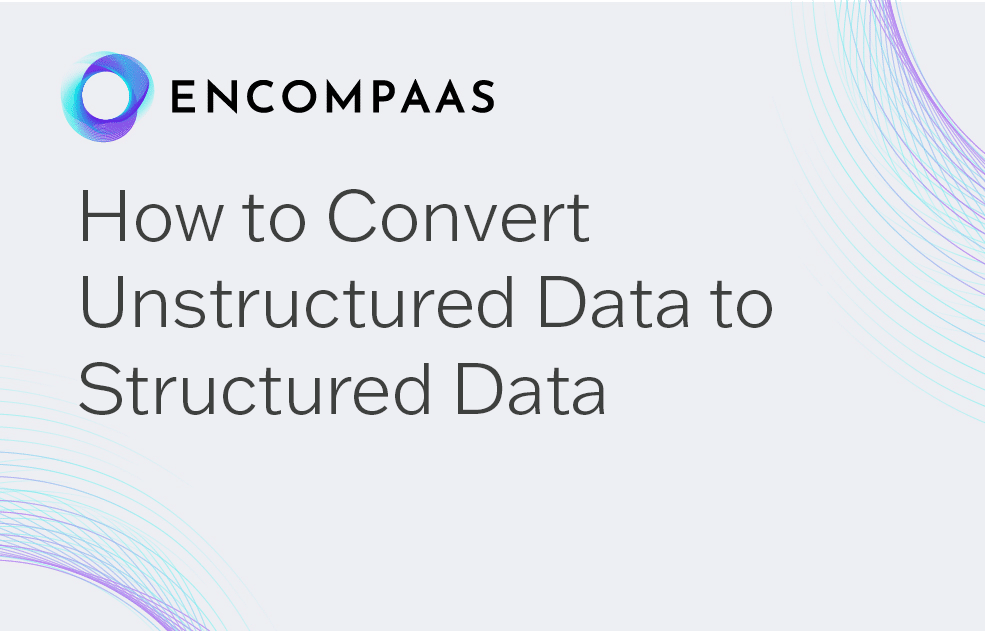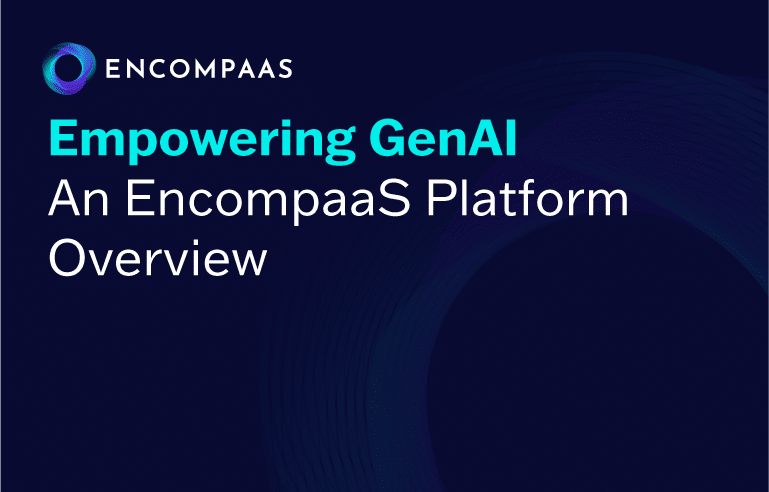How to Convert Unstructured Data to Structured Data
Authored by EncompaaS - Mar 12, 2023
Share

In today’s data-driven world, two key terminologies stand prominent – unstructured and structured data. Unstructured data, like emails, social media posts, and videos, lack a predefined format, making them harder to analyze with traditional methods.
On the other hand, structured data, such as spreadsheets, tabular data, and databases, have clearly defined formats that allow for straightforward analysis.
The process of converting unstructured data into a structured format is fundamental to businesses that wish to fully leverage their data capabilities and extract valuable insights to inform decision-making and strategic planning.
Join us as we explain how to convert unstructured data into structured data and optimize your business data the right way.
Main takeaways from this article:
- Understanding the distinct differences between unstructured and structured data is crucial in today’s data-driven business landscape.
- Converting unstructured to structured data can significantly improve data analysis, reporting capabilities, and decision-making processes.
- Various technologies, such as natural language processing (NLP) and data extraction tools, can be used in the conversion process.
- Maintaining data quality, privacy, and compliance is vital during the data conversion process.
- EncompaaS employs advanced AI and machine learning to automate the data conversion process, resulting in enhanced efficiency and data usability.
What is unstructured data?
Unstructured data refers to information that doesn’t adhere to a predefined data model, making it difficult to process and analyze. Examples include text documents, emails, social media posts, and videos. While unstructured data can provide deep human insights, its drawbacks are the challenges in organizing, interpreting, and extracting meaningful information from it.
What is structured data?
Structured data is organized and follows a specific format, such as Excel spreadsheets or SQL databases, enabling easy analysis. The benefits include ease of processing and improved search capabilities. However, creating and maintaining structured data can be labor-intensive and time-consuming, and it may not capture all data nuances, limiting its scope.
Why convert unstructured data to structured data?
In this age of data, understanding the limitations of unstructured data and the merits of its structured counterpart is of paramount importance. To enhance your business analytics, you must perform unstructured data analysis to extract valuable insights from your diverse data sources.
Unstructured data, such as social media posts, emails, word documents, and more, carry numerous challenges.
Let’s unravel these limitations:
- Restricted accessibility: The essential characteristic of unstructured data – its lack of organization – makes it difficult to access and interpret without the help of metadata, resulting in delayed decision-making processes.
- Inadequate capacity for efficient data analysis: Conventional tools and techniques deployed for data analysis often fall short when it comes to handling unstructured data, leading to inaccuracies and inefficiencies in the data interpretation process.
- Scalability concerns: With the data volume expanding significantly, managing and analyzing it effectively is becoming challenging, especially when it lacks a structured format.
Given these impediments, it’s clear why the conversion from unstructured to structured data is vital. It brings forth numerous benefits:
- Enriched data analysis: By converting data into a structured format, different analytics tools can interpret it easily, facilitating stronger and more efficient analysis. These streamlined processes often lead to better insights, helping businesses make strategic decisions.
- Better reporting: Structured data simplifies the process of generating informative reports. It gives a clear visibility into patterns, trends, and other important facets of the data, which can significantly aid in decision-making.
- Empowered decision-making: Structured data offers clarity, and this clarity is a big asset when it comes to business decision-making. The speed and the precision that structured data brings can be incredibly instrumental in today’s dynamic business landscape.
- Gen AI training: Structured data is crucial for Gen AI training as it provides clean, organized inputs that enable precise modeling and accurate predictive analytics. This data form helps streamline the learning process, enhancing the AI’s ability to generalize from examples and make informed decisions.
Now, let’s take a step further and understand how significant this conversion from unstructured to structured data is.
According to a study by the McKinsey Global Institute, businesses that leverage big data could increase their operating margins by up to 60%.
Furthermore, IDC predicts that by 2025, global data will increase to a staggering 175 zettabytes, from 33 zettabytes in 2018, with unstructured data accounting for 80% of this growth.
Hence, harnessing the power of structured data can be a game-changer.
Converting unstructured data to structured data
Understanding how to convert unstructured data into structured data is like trying to find a way through a dense forest. With infinite potential directions to lose yourself in with structured and unstructured data, having a detailed map can save you from getting lost.
This map, in our data-centric universe, takes the shape of a systematic process involving the identification, extraction, and transformation of structured and unstructured data. Implemented correctly, this three-fold approach can help you transform your raw, unstructured data into a polished, structured format ripe for analysis.
Let’s explore each of these steps:
- Data identification: This is your starting point, where you’ll need to scour through a massive pool of information and identify the relevant unstructured data. Data could be in any form, from scattered emails and social media posts to video feeds and audio files.
- Data extraction: Once you have identified the pertinent data, you need to extract it for further processing. You’ll be pulling out specific information from the vast ensemble of unstructured data sets.
- Data transformation: In this final step, the extracted data is transformed into a structured format. For instance, data could be arranged in rows and columns in a spreadsheet, offering a more organized view and making data analytics significantly easier.
Meeting these needs is where technologies such as Natural Language Processing (NLP), text analytics, and data extraction tools can come in handy.
- Natural Language Processing (NLP) is an AI-based technology that aids in understanding, interpreting, and manipulating human language. Its critical role lies in helping your organization make sense of unstructured text data. Using NLP, you can decode language patterns, extract meaningful information, and even understand the sentiment and tone of the language used.
- Similar to NLP, text analytics is another tool for dealing with unstructured text data. Going beyond just extraction, text analytics helps derive high-quality information from text through the processes of categorizing, clustering, tagging, and linking.
- Lastly, data extraction tools are specific software that aids in fetching data from a plethora of sites and databases. They can handle large volumes of data and are designed to cope with the web’s dynamic and unstructured nature.
By integrating these progressive technologies and following the outlined systematic approach, your business can process unstructured data and transform it into a structured format. This conversion gears you up to enhance your data analysis capabilities, improve decision-making processes, and drive your business toward a data-driven future.
Best practices for structured data conversion
If converting data into structured data is a necessary ingredient for an enriched decision-making process, getting this conversion right is a recipe for success.
Here are some of the best practices to consider:
1. Ensure data quality and accuracy
Checking the output of your conversion process is paramount to verifying its quality and accuracy. This involves a systematic validation procedure to identify potential issues and correct them in a timely manner.
To accomplish this, organizations may establish accuracy metrics and benchmarks or use special software that verifies the integrity and correctness of the transformed data. These steps help achieve accurate, reliable, structured data that can confidently be used for analysis and decision-making.
2. Maintain data privacy and compliance
With the growing trend of data regulation laws, such as the General Data Protection Regulation (GDPR) and the California Consumer Privacy Act (CCPA), it’s essential to ensure that data conversion processes comply with relevant rules and regulations.
This means anonymizing sensitive data, obtaining necessary permissions for data usage, and being transparent about how the data will be used. In addition, it’s important to implement secure data handling and storage procedures to guard against data breaches.
3. Continuously update data conversion methodologies
Data is ever-evolving. With new forms of unstructured data continuously emerging from different sources, your data conversion methodologies must adapt and evolve, too. Stay up-to-date with new tools and technologies that can handle diverse data types like LLMs and deep learning tools.
Update your protocols and practices regularly to accommodate these changes and ensure that your data transformation strategy remains flexible, robust, and relevant.
4. Utilize advanced tools
Through its advanced AI and machine learning capabilities, EncompaaS becomes the one-stop solution for transforming unstructured data into structured formats. Its intuitive user interface makes complex processes manageable, ensuring accuracy and efficiency.
Furthermore, EncompaaS ensures compliance with data privacy regulations, giving businesses peace of mind. By automating the conversion process, labor-intensive tasks are reduced, enhancing operational efficiency.
Explore EncompaaS as a vital data intelligence tool in your structured data conversion journey. Transform the way your organization handles vast amounts of unstructured data, turning it into a powerful resource for insightful decision-making.
How to analyze unstructured data
To leverage your data to its fullest potential, it’s crucial to master the art of unstructured data analysis. Through strategic methods and modern tools, it’s possible to glean meaningful, actionable insights from your cache of unstructured data.
Let’s delve into some techniques and strategies that can guide you in this endeavor:
- Sentiment analysis: Often used for interpreting social media commentary or customer reviews, sentiment analysis helps identify emotional tones and public opinion regarding your business. By converting unstructured data into a sentiment rating, you can better gauge customer satisfaction and brand perception.
- Trend-spotting: Recognizing patterns in unstructured data is pivotal in spotting trends and making informed strategic decisions. Advanced algorithms sift through massive sets of data and defined variables to identify recurring patterns or outliers, allowing you to stay on top of market changes and customer behavior. This could involve tracking sales, product uses, or demographic trends.
- Thematic analysis: This qualitative method pinpoints, analyzes, and reports patterns or themes within data. In the world of unstructured data, thematic analysis can help in understanding the frequently appearing topics, enabling companies to fine-tune their services or products to meet customer expectations.
Now, let’s take a moment to discuss the role of advanced analytics and machine learning in unstructured data analysis:
- Advanced analytics: Going beyond traditional analysis, advanced analytics uses modern techniques like machine learning, predictive analytics, and Big Data to deepen the insights gleaned from unstructured data. It can dig beneath the surface, uncovering patterns and correlations that might otherwise be hidden. Armed with this deeper insight, businesses can reveal opportunities for growth and improvements.
- Machine learning: Machine learning algorithms can be trained to analyze massive volumes of unstructured data quickly and efficiently. They can learn and improve from experience, recognizing intricate patterns and offering predictions based on those patterns. They can even adapt to new data types over time, making them a remarkably versatile tool for comprehending unstructured data.
It’s always critical to remember that while the extraction and conversion process may be complex, the insights gained from successfully analyzing unstructured data are invaluable. They can guide your business strategy, fuel product innovation, and drastically improve customer satisfaction.
Transform unstructured data with EncompaaS
Transforming unstructured data into actionable insights is crucial for businesses aiming to harness the full potential of their information assets.
EncompaaS offers a robust solution for managing and converting unstructured data into structured formats. By automating data governance and compliance processes, EncompaaS ensures that data is not only accurately categorized and stored but also adheres to relevant regulatory standards.
With EncompaaS, operations are streamlined, and data compliance and privacy are maximized, easing the often daunting task of data conversion.
Explore how EncompaaS can tailor to your organization’s specific data conversion needs and further optimize your business processes. Book a demo today!
FAQs
What are common methods for converting unstructured data to structured data?
Common methods include text parsing, where specific information is extracted using patterns or keywords; natural language processing (NLP) for understanding and categorizing text data; and image recognition technologies that identify and classify objects in images or videos into structured formats.
What tools can assist in the conversion of unstructured to structured data?
Tools such as Apache NiFi for data flow automation, Talend for data integration, and Python libraries like Pandas for data manipulation are effective. Machine learning platforms like TensorFlow and PyTorch also offer algorithms that can automate the extraction of structured information from unstructured datasets. Additionally, EncompaaS can play a crucial role in this process by providing governance and compliance automation, which helps in organizing and securing converted data effectively.
What are the challenges involved in converting unstructured data to structured data?
The conversion process can be complex and resource-intensive, often requiring advanced algorithms to interpret and categorize the data accurately. Additionally, maintaining the accuracy and consistency of the data during conversion is challenging, especially when dealing with large volumes of diverse data types.
Book a demo
Let's get started
Experience the Power of EncompaaS!
Submit this form to see EncompaaS in action with a demo from our information management experts.
Related Resources

- Press
Atturra and EncompaaS Partner to Ensure Successful Agentic AI Adoption by Enterprises
Australia-based partnership leverages EncompaaS’ AI-powered platform and Atturra’s technology deployment experience to deliver AI-ready foundations for clients across ANZ. Sydney, Australia – Tuesday, November 11,…
Learn More




